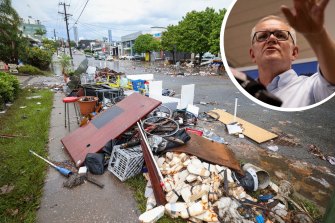The tight media management around Scott Morrison’s visit to Lismore said everything about the anxiety within the government about the fury at the Prime Minister over the country’s latest natural disaster.
The Prime Minister’s office arranged quiet visits to flood victims to ensure the only images that emerged were taken by his personal photographer at a safe distance from those who gathered in town to give Morrison a piece of their mind.
Prime Minister Scott Morrison visited the flood sites in Lismore.Credit:Janie Barrett
Two years after a young woman refused to shake his hand during the “black summer” bushfires, Morrison was in danger again from the fury of Australians who have been kept waiting for help.
Morrison tried to control the damage on Wednesday by promising more money for victims in Lismore and other parts of the NSW northern rivers while making a formal statement about a national emergency across NSW and Queensland to trigger federal emergency powers.
The payments will offer real help because they triple the cash for many households in the Lismore, Richmond Valley and Clarence Valley local government areas. Those who qualify for the standard disaster payment, worth $1,000 per adult and $400 per child, will gain two further payments on March 15 and March 22.
“I don’t think any amount of support is ever going to be enough,” Morrison said.
“That’s why I do apologise that the amount of support that has been provided and continues to be provided, I still don’t believe will always meet the expectations that are just at very high levels, and understandably so.”
Yet the formal declaration of the disaster only raised a national political question about why the decision was not made earlier.
Labor could see Morrison was in trouble days ago. The Labor deputy, Richard Marles, arrived in Lismore on Monday with the Opposition spokesman on emergency management, Murray Watt, to slam the “total absence” of federal operations to help the locals.
The reality, of course, is that the federal government has been doing what it usually does. It has paid thousands of claims for assistance and it has sent the Australian Defence Force into flood zones to help. Seeing the Labor attack, the government started issuing updates on Tuesday to list all the money being paid and the other help being offered.
By Wednesday, the federal assistance included $385.2 million in payments to 330,900 people and the deployment of 4,370 members of the ADF.
But that help has come too late. Stories emerged on Monday of people in Lismore resorting to a crowdfunding scheme to hire a helicopter. That compounded the impression of a federal vacuum after Defence Minister Peter Dutton was criticised ten days ago for backing a crowdfunding effort to help Queensland flood victims.
One of the lessons from the bushfires two years ago is that Australians expect the ADF to offer swift aid in a natural disaster. They do not expect to have to crowdfund the choppers.
This has given Labor leader Anthony Albanese a powerful national issue close to the election. He intensified his criticism on Tuesday by calling for faster decisions at the top to deploy the ADF, while being careful not to criticise the defence chiefs.
The frustration in the government is obvious because the assistance was always available to Queensland and NSW. Asked on February 27 if he would send in the ADF, Morrison said he had already made the offer. He said all the premiers had to do was ask.
“They will be used only if the Premier asks for them?” a reporter asked.
“Yeah, well, yes, that, I mean, because they’re running the show,” Morrison replied.
This is the same dynamic from two years ago. The help is there for those who ask. This is dangerous for Morrison because it can cement the impression of a passive prime minister rather than a leader who takes the initiative.
And the timing could not be worse. Morrison wants to repeat history by winning the election against the odds. Now, however, he finds himself repeating history with a natural disaster.
Most Viewed in Politics
From our partners
Source: Read Full Article
